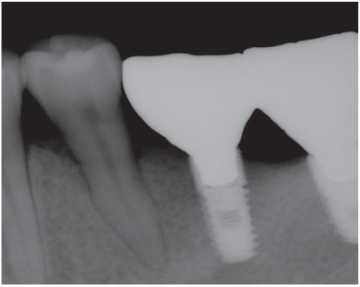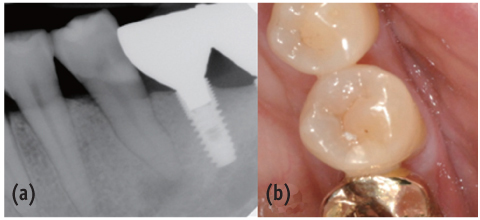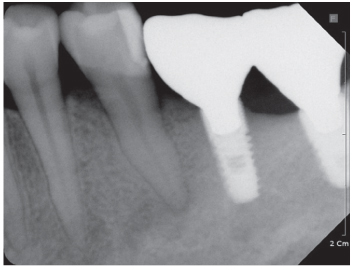Articles
- Page Path
- HOME > Restor Dent Endod > Volume 37(2); 2012 > Article
- Case Report Vital tooth with periapical lesion: spontaneous healing after conservative treatment
- Hyun-Joo Kim, DDS, Seung-Jong Lee, DDS, PhD, Il-Young Jung, DDS, PhD, Sung-Ho Park, DDS, PhD
-
2012;37(2):-126.
DOI: https://doi.org/10.5395/rde.2012.37.2.123
Published online: May 18, 2012
Department of Conservative Dentistry, Yonsei University College of Dentistry, Seoul, Korea.
- Correspondence to Sung-Ho Park, DDS, PhD. Professor, Department of Conservative Dentistry, Yonsei University College of Dentistry, 134 Shinchon-dong, Seodaemun-gu, Seoul, Korea 120-752. TEL, +82-2-2228-3147; FAX, +82-2-313-7575; sunghopark@yuhs.ac
• Received: December 27, 2011 • Revised: March 5, 2012 • Accepted: April 6, 2012
©Copyights 2012. The Korean Academy of Conservative Dentistry.
- 1,515 Views
- 25 Download
Abstract
- It is often presumed that apical periodontitis follows total pulp necrosis, and consequently root canal treatment is commonly performed. Periapical lesion development is usually caused by bacteria and its byproduct which irritate pulp, develop pulpitis, and result in necrosis through an irreversible process. Afterwards, apical periodontitis occurs. This phenomenon is observed as an apical radiolucency in radiographic view. However, this unusual case presents a spontaneous healing of periapical lesion, which has developed without pulp necrosis in a vital tooth, through conservative treatment.
- 1. Kim IS, Kim SG, Kim YK, Kim JD. Position of the mental foramen in a Korean population: a clinical and radiographic study. Implant Dent. 2006;15: 404-411.ArticlePubMed
- 2. Resnick CM, Novelline RA. Cemento-osseous dysplasia, a radiological mimic of periapical dental abscess. Emerg Radiol. 2008;15: 367-374.ArticlePubMedPDF
- 3. Romanos GE, Froum S, Costa-Martins S, Meitner S, Tarnow DP. Implant periapical lesions: etiology and treatment options. J Oral Implantol. 2011;37: 53-63.ArticlePubMedPDF
- 4. Kovacević M, Tamarut T, Jonjić N, Braut A. The transition from pulpitis to periapical periodontitis in dogs' teeth. Aust Endod J. 2008;34: 12-18.ArticlePubMed
- 5. Khayat BG, Byers MR, Taylor PE, Mecifi K, Kimberly CL. Responses of nerve fibers to pulpal inflammation and periapical lesions in rat molars demonstrated by calcitonin gene-related peptide immunocytochemistry. J Endod. 1988;14: 577-587.ArticlePubMed
- 6. Byers MR, Taylor PE, Khayat BG, Kimberly CL. Effects of injury and inflammation on pulpal and periapical nerves. J Endod. 1990;16: 78-84.ArticlePubMed
- 7. Caviedes-Bucheli J, Muñoz HR, Azuero-Holguín MM, Ulate E. Neuropeptides in dental pulp: the silent protagonists. J Endod. 2008;34: 773-788.ArticlePubMed
- 8. Stashenko P, Teles R, D'Souza R. Periapical inflammatory responses and their modulation. Crit Rev Oral Biol Med. 1998;9: 498-521.ArticlePubMedPDF
REFERENCES
Figure 1

Preoperative periapical view and clinical photograph. (a) Periapical radiolucency on #35; (b) Cervical abrasion.

Figure 2

Preoperative panorama view. Periapical radiolucency was observed at the apex of mandibular left second premolar.

Tables & Figures
REFERENCES
Citations
Citations to this article as recorded by 

Vital tooth with periapical lesion: spontaneous healing after conservative treatment











Figure 1
Preoperative periapical view and clinical photograph. (a) Periapical radiolucency on #35; (b) Cervical abrasion.
Figure 2
Preoperative panorama view. Periapical radiolucency was observed at the apex of mandibular left second premolar.
Figure 3
Periapical view taken 2 years ago.
Figure 4
Location of mental foramens (dotted line) and periapical radiolucency (arrow).
Figure 5
Periapical view and clinical photograph after class V Resin filling.
Figure 6
Three-month follow up. (a) Periapical view. Distal proximal caries was detected; (b) Photograph taken after class II resin filling.
Figure 7
Six-month follow up. Periapical view.
Figure 8
Nine-month follow up. Periapical view.
Figure 9
Fourteen-month follow up. Clinical photographs.
Figure 10
Fourteen-month follow up. Horizontal shift periapical view.
Figure 11
One year before implant surgery: Note that the posterior area of mandibular left segment was edentulous.
Figure 1
Figure 2
Figure 3
Figure 4
Figure 5
Figure 6
Figure 7
Figure 8
Figure 9
Figure 10
Figure 11
Vital tooth with periapical lesion: spontaneous healing after conservative treatment

 KACD
KACD









 ePub Link
ePub Link Cite
Cite

